Connect 3D and Sapphire Blizzard Radeon X1900 XTX
by Josh Venning on April 10, 2006 12:05 AM EST- Posted in
- GPUs
Overclocking, Power, Heat & Noise
As usual, we wanted to see how well these cards overclocked over the factory speeds, particularly with the water cooled Blizzard X1900 XTX. We've done enough overclocking in the past to know that no matter how a particular card may look, there's no guarantee that it will achieve a high overclock, so we weren't sure what to expect with this card.
As with our last X1900 article, our usual ATI overclocking tool (Powerstrip) didn't work so we used ATITool to get our overclocks. As we explained before, we found that the clock speeds indicated by ATITool weren't quite accurate, with performance being slightly lower than the numbers represent. We were still able get an idea of how well these cards overclock, and these are the clock speeds we achieved.
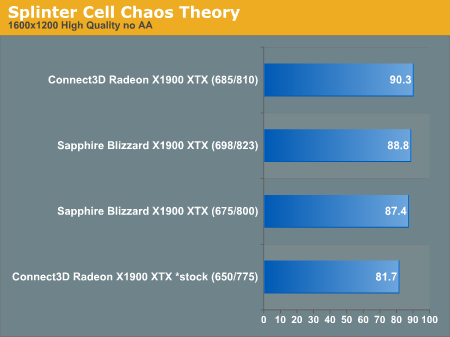

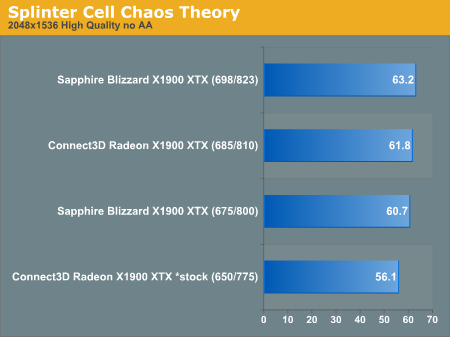
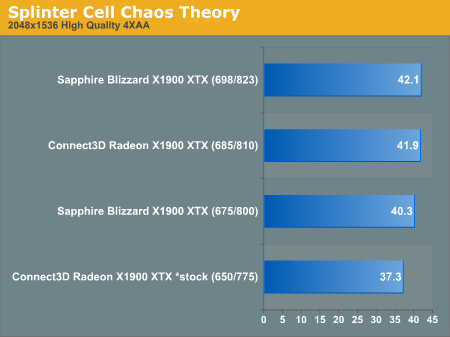
* Keep in mind that the clock speeds shown are actually a little higher than the real clock speeds.
Power

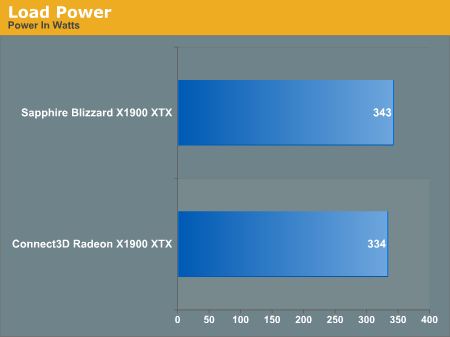
It makes sense that the Blizzard X1900 XTX setup would have a higher power draw than the Connect3D, or any of the standard X1900s around, because the water block requires an extra power connection to run the pump, especially considering the results of our heat tests which follow. This is something that will probably dissuade those who are concerned with the power load on their system from considering this card.
Heat
We were also able to get an idea of how much heat these two cards generated with ATITool.
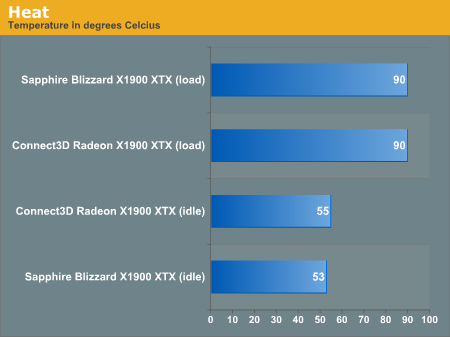
The Connect3D X1900 XTX quickly came up to temperature and ran without any problems under stress testing, but we found that the Blizzard X1900 XTX acted a little differently. The Blizzard would come up to peak temperature much more slowly than the Connect3D, no doubt due to the water cooling system, but under testing with this card using ATITool there was some slight trouble keeping it stable for long periods of stress. Water has a much higher thermal capacity than air, allowing the coolant to absorb quite a bit of heat; however, the radiator doesn't appear sufficient to keep the card at a lower temperature under extended testing, so eventually it reaches higher temperatures than you might expect. We aren't sure if this is the case for all Blizzard X1900 XTXs, but we did find that it ran extended stress tests with Splinter Cell Chaos Theory without any trouble, so we concluded that there most likely wouldn't be any issues with this card and long periods of actual gaming (as opposed to synthetic benchmark stressing).
Noise

One of the purported benefits of the Blizzard water cooled X1900 XTX is that it will supposedly generate significantly less noise than an air cooled solution. We measured the sound levels of both cards and found that this is in fact the case. While the Blizzard isn't exactly "silent" like Sapphire suggests, we are impressed by how quiet the card is during operation, especially considering how noisy X1900 cards tend to be.
As usual, we wanted to see how well these cards overclocked over the factory speeds, particularly with the water cooled Blizzard X1900 XTX. We've done enough overclocking in the past to know that no matter how a particular card may look, there's no guarantee that it will achieve a high overclock, so we weren't sure what to expect with this card.
As with our last X1900 article, our usual ATI overclocking tool (Powerstrip) didn't work so we used ATITool to get our overclocks. As we explained before, we found that the clock speeds indicated by ATITool weren't quite accurate, with performance being slightly lower than the numbers represent. We were still able get an idea of how well these cards overclock, and these are the clock speeds we achieved.
| Overclocking Speeds | ||
| Graphics Card | Core (in MHz) | Memory (MHz) |
| Sapphire Blizzard X1900 XTX | 698 | 823 |
| Connect 3D X1900 XTX | 685 | 810WS |




* Keep in mind that the clock speeds shown are actually a little higher than the real clock speeds.
Power


It makes sense that the Blizzard X1900 XTX setup would have a higher power draw than the Connect3D, or any of the standard X1900s around, because the water block requires an extra power connection to run the pump, especially considering the results of our heat tests which follow. This is something that will probably dissuade those who are concerned with the power load on their system from considering this card.
Heat
We were also able to get an idea of how much heat these two cards generated with ATITool.

The Connect3D X1900 XTX quickly came up to temperature and ran without any problems under stress testing, but we found that the Blizzard X1900 XTX acted a little differently. The Blizzard would come up to peak temperature much more slowly than the Connect3D, no doubt due to the water cooling system, but under testing with this card using ATITool there was some slight trouble keeping it stable for long periods of stress. Water has a much higher thermal capacity than air, allowing the coolant to absorb quite a bit of heat; however, the radiator doesn't appear sufficient to keep the card at a lower temperature under extended testing, so eventually it reaches higher temperatures than you might expect. We aren't sure if this is the case for all Blizzard X1900 XTXs, but we did find that it ran extended stress tests with Splinter Cell Chaos Theory without any trouble, so we concluded that there most likely wouldn't be any issues with this card and long periods of actual gaming (as opposed to synthetic benchmark stressing).
Noise

One of the purported benefits of the Blizzard water cooled X1900 XTX is that it will supposedly generate significantly less noise than an air cooled solution. We measured the sound levels of both cards and found that this is in fact the case. While the Blizzard isn't exactly "silent" like Sapphire suggests, we are impressed by how quiet the card is during operation, especially considering how noisy X1900 cards tend to be.










24 Comments
View All Comments
Gioron - Thursday, April 13, 2006 - link
As soon as I saw the cooling system I had flashbacks to http://www.dansdata.com/aguatec.htm">this review and http://www.dansdata.com/thermagic.htm">this almost as bad review. There is almost no situation where the water cooling card is a good idea. There is no magic mystical power of water to cool things down, its just an easy way to transfer heat from one place to annother. In the case of most sane water cooling rigs, this means transfering the heat from the small CPU contact patch to the large efficient/quiet radiator elsewhere. You lose efficiency by adding water to the loop, but you more than make up for it with a huge unwieldy radiator that would never fit on the CPU under normal circumstances.However, in this situation (and in the first linked review) you're moving the heat from the processor contact to a radiator thats exactly the same size and efficiency as one you could attach directly to the processor, which means you lose efficiency moving the heat and then have no way to make up for it. As noted in the article, it does take a bit for the water to warm up which slows the temperature increase, but the final temperature MUST be higher than the temperature of the same heat sink just bolted directly onto the core. Anyone who even glanced at a thermodynamics textbook can tell you that. You may be able to get the water cooling system close to the efficiency of a normal heat sink, but you'll never exceed it and the marketing speel is complete and utter BS.
There is, however, one possible use for this card. Some shuttle boxes have the GPU slot right next to the side of the case, preventing the installation of cards with dual slot coolers. You can use this card to move the heatsink on the other side of the card and get cooling almost as good as a dual slot cooler, but the real solution to this problem is just for the case to be constructed such that dual card coolers will actually fit. (And since I haven't looked at shuttle cases much since I bought mine, they may actually have figured this out by now, leaving this card to be completely pointless.)
tekkstore - Monday, April 17, 2006 - link
https://www.tekkstore.com">tekkstore.comtekkstore - Monday, April 17, 2006 - link
https://www.tekkstore.com">tekkstore.comyacoub - Wednesday, April 12, 2006 - link
Fixed it for you. The numbers listed indicate they are both very loud and neither would be appropriate for a quiet system or HTPC.
jmke - Tuesday, April 11, 2006 - link
Hello, are these "A" weighed?jmke - Tuesday, April 11, 2006 - link
forgot to ask; at what distance? was the card inside a case?haelduksf - Monday, April 10, 2006 - link
"Bigger reservoir = more heat capacity" is a common myth, but a myth none the less. Adding more water to a loop doesn't result in any meaningful increase in heat capacity, and a larger res usually puts more strain on your pump to boot.NegativeEntropy - Monday, April 10, 2006 - link
I think what you menat was more water does not equal lower temps. By definition more coolant does indeed increase the total heat capacity of the system assuming the same fluid.JarredWalton - Monday, April 10, 2006 - link
Exactly, which is what was intended in this article.If you have a gallon of water vs. a quart of water, both at 25 C, the gallon can absorb 4X as much heat before turning to vapor (not that you'd ever get it that hot with a computer system....) Taken to the extreme, you could have a system sucking water from the ocean and spewing back slightly warmer water into the ocean, and it would never really change the ocean's temperature. The only extra strain on a pump would be if the pump has to pull/push water through more pipes.z3R0C00L - Monday, April 10, 2006 - link
Actually adding more water can make a difference provided you have a larger heat dissipator (radiator).But I do agree adding more water does not mean better temps.. you need a larger dissipator to remove the heat from that extra water. At least using the logic I have an x1900XT clocked at 750/1700 using water and no voltage tweaks or increases.